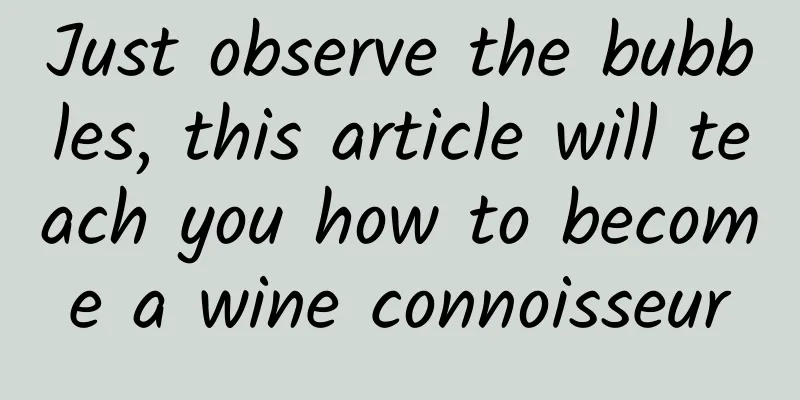Just observe the bubbles, this article will teach you how to become a wine connoisseur

|
Author: Deuterium The article comes from the Science Academy official account (ID: kexuedayuan) —— Jay Chou's song "Mojito" recently made foreign liquor and cocktails popular. Before drinking, have you ever noticed the small bubbles in the glass that look like pearl necklaces? I guess everyone has seen it, but few people know that there is a close relationship between the bubbles in the glass and the quality of the wine. However, the masters of Mexican tequila have already mastered this traditional art. What is tequila? Whether you have tried tequila or not, you have probably heard of its name. Tequila is the national drink of Mexico, and some even say it symbolizes the Mexican spirit. It became known to the world during the 1968 Mexico City Olympics, and is now one of the most common base liquors in bars, including Tequila Sunrise, Frozen Margarita, and other cocktails. Various types of tequila (Image source: Wikipedia) Tequila is not a certain brand, but a general term for a type of liquor with specific raw materials and brewing techniques, just like our Chinese sorghum wine and glutinous rice wine. The raw material agave itself is also a general term for a large type of plants. The members of this family look like giant aloe vera, with a large cluster of sword-like leaves rising from the ground. The single leaf is slender and thick, and sometimes has serrations on the edge, which is very similar to the tongue of the evil dragon in Western mythology, so it is called "dragon tongue". Agave is native to tropical America, and the dry and hot climate of Mexico is very suitable for its growth. More than a thousand years ago, the indigenous Indians of Mexico mastered the fermentation and winemaking technology, and found that the leaves of Agave are rich in sugar and juice, which is simply a godsend for winemaking. Later, Spanish colonists landed on the American continent and brought distillation technology, and today's strong tequila (Mezcal) was born. Blue Agave (Image source: Wikipedia) There are more than 130 species of agave in Mexico, but only a few can be used for making wine. Tequila, which is equivalent to China's "Moutai", must use blue agave from certain regions. The process of brewing tequila is very complicated. The harvested agave is peeled off, leaving the juicy grass core, placed in a fermentation tank, and sprinkled with yeast. After fermentation, it is distilled and the original liquor is aged in wooden barrels. It can only be opened and tasted after a certain period of time. This is just a brief description of the process of brewing tequila. The actual operation is very complicated, and the temperature and time of each link need to be precisely controlled. To this day, brewing high-quality tequila is still not fully automated, but relies on the experience of the brewer. How can you tell the quality of a wine by looking at its bubbles? The varied raw materials and complex processes can easily lead to unstable quality of tequila. How can winemakers accurately grasp this? Observing bubbles is a very important practical skill. The winemaker lets the wine flow through a thin tube into a small bowl, which naturally stimulates a string of bubbles. If the entire bubble can last for about 30 seconds (a single bubble lasts for a few tenths of a second), it means that the content of alcohol and flavor molecules in the tequila is just within the right range and it is ready to be opened and drunk. The bubbles will disappear quickly if the alcohol content is higher or lower than 55 degrees. Previous studies have shown that a similar phenomenon also occurs in whiskey. Winemakers judge the alcohol content of tequila by observing how long the bubbles last (Image source: Scientific Reports) Is this simple phenomenon accurate? Is there any scientific basis for it? Recently, Professor Zenit's team at Brown University in the United States (who are also tequila lovers) put it to the test and provided a scientific footnote to the experience passed down for hundreds of years. The bubbles produced by splashing or shaking a liquid are actually a thin layer of water film. As time goes by, gravity causes the water in the water film to fall back into the liquid, and the water film becomes thinner and thinner, and when it reaches a certain point, it will burst by itself. What affects the life of bubbles? Alcohol concentration must be the main factor, but there may be other substances that help. First, the researchers tested the bubble life of 55-degree tequila under standard laboratory conditions and added different amounts of water or alcohol to it to demonstrate the effect of alcohol content on bubble life. It can be clearly seen that, as the winemakers have mastered, 55-degree tequila has the longest bubble life, and even if it deviates by only 1 to 2 degrees, the bubble life will be greatly shortened. They also did something interesting. Since the alcohol content is so important, what happens when you mix 55-proof tequila with 55-proof alcohol? Unexpectedly, the life of the bubbles is also significantly shortened. This shows that in addition to alcohol, there are other substances in tequila that can affect the life of bubbles. As we all know, in addition to water and ethanol, there are also a wide variety of trace organic molecules in wine, mainly some alcohols, aldehydes, esters, organic acid molecules, and even proteins. These organic substances contain both hydrophobic and hydrophilic groups, so they can be regarded as surfactants. It makes sense to think in this way, because water with surfactants is easy to foam. Tequila bubble life test. Red is 55% tequila, blue is tequila with water or ethanol, and black is tequila mixed with 55% alcohol (Image source: Scientific Reports) At this point, the idea of studying the problem is very clear. Next, we will split into two groups to explore the effects of alcohol concentration and surfactant respectively. First is the alcohol concentration. Since this study hopes to compare numerical simulation and experimental results, in order to simplify the model, the researchers used a simple water/ethanol solution (alcohol) instead of tequila. It can be clearly seen from the curve that the bubble life is longest when the alcohol concentration is around 55 degrees. The experimental results (blue curve) and computer simulation results (red data points and black curve) are basically consistent in trend. In addition, during the model derivation process, the researchers believed that viscosity is likely to affect the life of bubbles. And the facts also prove that 55-degree alcohol has the highest viscosity (the orange dotted line represents viscosity). These results once again prove the accuracy of the winemaker's experience and the rationality of the researcher's model construction. The relationship between alcohol concentration and bubble life. The blue color is the experimental result, the red and black colors are the simulation results under different conditions, and the orange dotted line is the viscosity change. All solutions contain 0.025 mol/L of surfactant (Image source: Scientific Reports) From the previous discussion, we already know that surfactants can greatly increase the life of bubbles. The researchers also verified this experimentally. When the surfactant concentration is doubled from 0.0125 mol/L to 0.025 mol/L, the bubble life is increased by dozens of times! However, further increasing the surfactant concentration is no longer effective. In addition, the addition of surfactants does not affect the curve trend of the relationship between alcohol content and bubble life. Relationship between alcohol concentration and bubble life under different surfactant concentrations (the author suspects that the Y-axis value of this figure is wrong and should not be so small) (Image source: Scientific Reports) Why can surfactants stabilize bubbles? Under a high-speed camera, researchers observed that after bubbles are formed, the liquid on the water surface flows toward the bubble's liquid film, which to some extent offsets the effect of gravity on the thinning of the liquid film, thus extending the life of the bubble. This is consistent with the phenomenon of the Marangoni effect. Simply put, the surfactants present in tequila reduce the surface tension of the liquid surface, and the liquid film of the bubble is a curved liquid surface, and the surfactant molecules distributed on the surface are thinner. In other words, the surface tension of the liquid film is higher than the liquid surface of the wine. This surface tension difference will drive the liquid from the wine to the liquid film, extending the life of the bubble. At the same time, alcohol itself will reduce the surface tension of water, and the curved liquid surface evaporates slower than the horizontal liquid surface, which will also produce a similar driving force. The author believes that they all contribute to the stabilization of bubbles. In fact, the Marangoni effect is often used in wine identification, and the "tears of wine" phenomenon (actually wine clinging to the glass) can also be explained by this effect. Schematic diagram of the principle of Marangoni effect stabilization of bubbles (Image source: original by the author) In summary, surfactants and appropriate alcohol concentration can greatly extend the life of bubbles, which together create the phenomenon of super long-life bubbles in 55-degree tequila. By observing the life of bubbles, in addition to judging the alcohol content, it is also possible to preliminarily judge whether the wine is contaminated, because a small amount of contaminants may reduce the surface tension of the wine, making the bubbles abnormally "long-lived". At this point, the secret of tequila bubbles is basically clear. The author admires the Mexican winemakers for summarizing such precise experience from practice, and also praises Professor Zenit's team for being good at discovering interesting problems in production and life. I won't say any more, let's go get a glass of tequila with bubbles for a long time~ References: [1] Rage, G., Atasi, O., Wilhelmus, MM et al. Bubbles determine the amount of alcohol in Mezcal. Sci Rep 10, 11014 (2020). https://doi.org/10.1038/s41598-020-67286-x [2] https://www.eurekalert.org/pub_releases/2020-07/bu-srs070720.php [3] Wikipedia |
>>: Have you ever seen a pterosaur taller than a giraffe?
Recommend
Industrial or craft beer? Look for these two points to easily buy cheap and good beer
In the hot summer, besides air conditioning and w...
Divergence or coexistence? A detailed explanation of Android kernel security
1. Knowledge Background In October 2003, Andy Rub...
The mid- to long-term development plan of the automobile industry may become a breakthrough opportunity for domestic brands
Wu Songquan, director of the Policy Research Cent...
Practical application of Internet finance: Who touched your promotion fees?
If you are attracting new customers for an Intern...
Money comes in but cars are not produced: Internet car companies are in trouble
Since the beginning of this year, Tesla, the worl...
How to get the “traffic key” of the Winter Olympics hot spots?
During the past Spring Festival holiday, Video Ac...
An inventory of the most comprehensive marketing methods of the 200 billion Pinduoduo
On the evening of July 26, Pinduoduo, which had b...
3 new strategies for short video account positioning
One writer once said: "Go deeper into the ar...
Windows 10 cannot be activated? Try this trick
Microsoft officially launched the Windows 10 Buil...
How do Xiaohongshu, Zhihu, etc. acquire seed users?
Seed users refer to those who actively interact w...
The fate of a man's brother and a man's god pdf electronic version_online reading
This book explains in detail everything from pers...
How does QR code marketing increase the scanning rate?
In the future, data will serve as a factor of pro...
Gentle White is Not White · Douyin 0-cost project: single-day income of 500, no work release, no account maintenance [video course]
Gentle White is Not White · Douyin 0-cost project...
Tip of the tongue phenomenon: Why can’t you remember the words that are on the tip of your tongue?
© The Lily Leviathan Press: We all have this expe...
If the promotion is ineffective, you need a manual to prevent scams!
After begging for help, drinking and singing and ...









